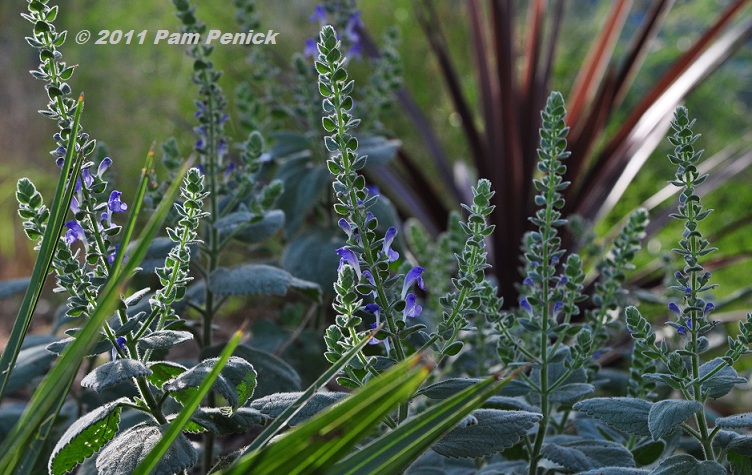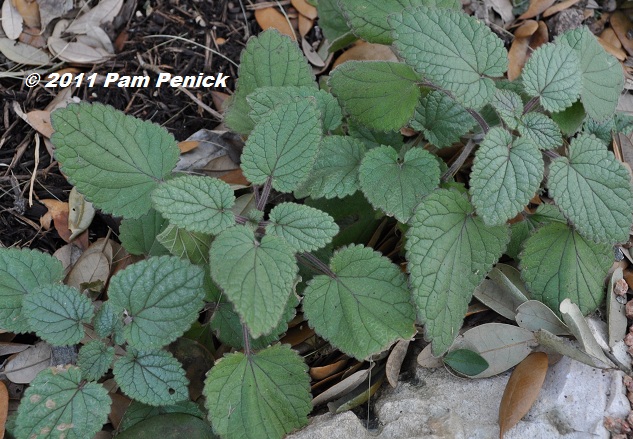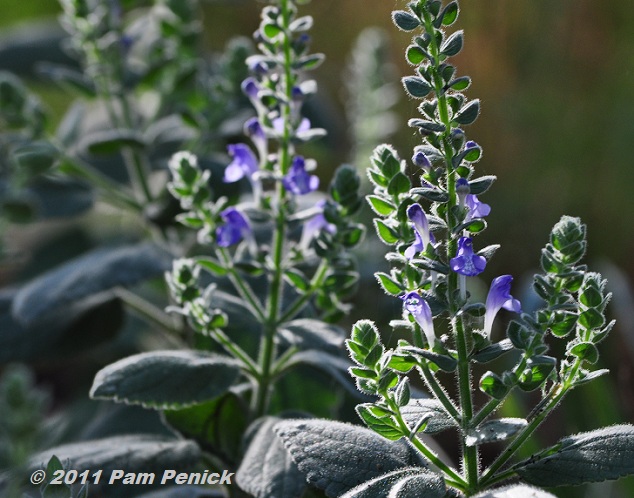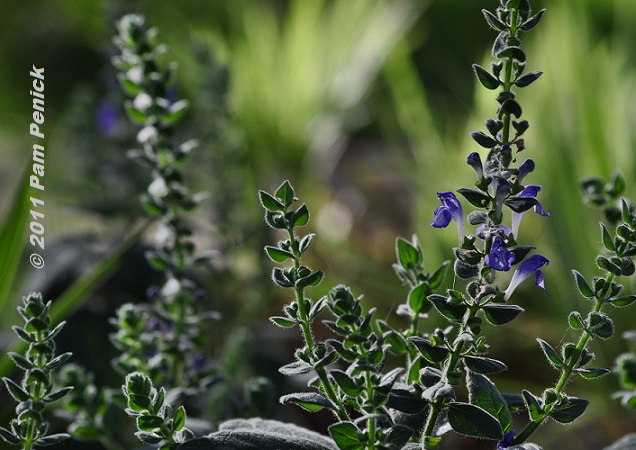Plant This: Heartleaf skullcap
Heartleaf skullcap (Scutellaria ovata) romps through my garden with greater vigor each year. Belonging to the mint family, it spreads with abandon, and yet it never seems a thug because it’s so easy to pull out and dies back in summer to let other plants have their turn. This lovely groundcover for spring color is native to central Texas and indeed much of the U.S., and I’m surprised it’s not more widely available.
Pretty, blue-green leaves that feel both fuzzy and oily are the opening act in late winter. Reappearing from summer dormancy, they grow steadily taller on long stems, to about one foot in height, as spring progresses.
Pale, fuzzy buds lengthen for weeks, and in late April or May they open into diminutive towers of lavender-blue flowers. All those fuzzy hairs give this plant a wondrous light-catching quality.
Heartleaf skullcap (lower foreground) grows well in dry part shade and dappled shade. Deer have avoided it in my front garden, no doubt because of the hairy, oily texture of the leaves. Because it dies back when it gets hot, plant a summer star behind it, to take the stage when the skullcap exits the scene; Turk’s cap or Salvia guaranitica would be two good choices.
It spreads aggressively by seed and by underground stolons. Embrace this quality or plan to lift the rosettes of volunteers in early spring to share with friends.
Note: My Plant This posts are written primarily for gardeners in central Texas. The plants I recommend are ones I’ve grown myself and have direct experience with. I wish I could provide more information about how these plants might perform in other parts of the country, but gardening knowledge is local. Consider checking your local online gardening forums to see if a particular plant might work in your region.
All material © 2006-2011 by Pam Penick for Digging. Unauthorized reproduction prohibited.






How does heart-leaf skullcap compare with lyre-leaf sage in terms of habit/shade tolerance/etc?
They are very similar, Katie. In fact they grow in the same conditions in my garden, although I’d say that heartleaf skullcap is more aggressive. —Pam
Nice! I’m not familiar with this plant but it looks (and sounds) like one I would adopt! I’ll look for it next time I’m at the nursery!
Looks like a fantastic border plant! I’ve used the Scutellaria in designs that is called Veranda by its common name (at least out here!). But the leaves look a lot more glossy than Scutellaria ovata. It seems quite the diverse genus as the native range for the different species range from tropical Central America all the way to Siberia! I definitely need to look more into these plants for use as perennials and annuals! Thanks Pam!
This is tempting – do you know if it’s hardy in Zone 7? Although I am often a bit wary when a seasoned garden designer says a plant is aggressive. Still . . .
I read online that it’s native all the way up to Minnesota, Melissa. I expect its growing habit differs in a cooler climate; perhaps it doesn’t die back in summer. —Pam
Cool. I managed to get the lyre-leaf sage at my local nursery this year…here’s hoping I can find heartleaf skullcap next year! Is that Texas betony growing down the bed from it in the picture above w/ daylily & salvia guarantica? Nice combo!
Thanks, Katie. Yes, the red flowers in that picture are Texas betony. —Pam
I’m so glad you posted about one of my favorites! I push it on people at the nursery I work at who are looking for a dry shade bloomer (very difficult). I planted three transplants in one of my front beds last fall and now have 30 plants all budded and ready to bloom. But like you said, it can easily be pulled and transplanted elsewhere or tossed in the compost pile if it’s really too much.
Katie asked how it compares with lyre-leaf sage. I would agree with most of what you said, but don’t you find that lyre-leaf can be more aggressive from a can’t-get-rid-of-it standpoint? I have it growing out of my beds into my lawn and I can’t get rid of it, not that I really want to. But heartleaf pulls right up. Anyway. Thanks for the post on a great, underappreciated plant!
My pleasure, Curtis. It’s interesting to hear your perspective on the two plants. I don’t have a problem with lyre-leaf sage spreading to the extent that you have. But I can believe it. In my own garden, heartleaf skullcap is the bigger aggressor, but overall they’re pretty similar. —Pam
I’ve got a boatload of mealy blue sage transplants I’ll trade you for some skullcap transplants. Too bad were not neighbors.
I’ll send you some seeds, Greggo. —Pam
Reading my new issue of “Garden Design” yesterday I came upon a reference to you in an article about plant sitters. She said your garden of vegetables was well tended in your absence. Since it seems your garden is ornamental rather than edible I was puzzled. Have you seen that article?
Ha, yes, I saw it yesterday, and you’re right. Somehow there was a misunderstanding during the interview, as my garden is and always has been largely ornamental. Other than that, I thought the information they provided about hiring garden sitters was spot-on. —Pam
Pam, I’m laughing … I just posted about heartleaf skullcap yesterday and my message was “Friends don’t let friends plant Heartleaf Skullcap.” In my Katy garden, it’s overly vigorous. I might tolerate its thuggish tendencies better if it were as profuse in bloom as yours are. I’ve been disappointed by how few flowers I see on my plants.
Cindy, I read your post yesterday and was laughing at the contrast in our opinions about it too. In fact, I tried to leave you a comment twice (using the Name/URL option), but both times I got bounced out to a general Blogger page asking me to set up an account. It happened on another Blogger blog also. A glitch in the commenting system, I guess. Anyway, thanks for popping by! —Pam
That’s beautiful! I will keep my eye out for it, though I have few shady spots in my garden.
Pam,
Thrilled to see you writing about my favorite plant. I love it for the gray green leaves and contrast in my garden. I just let it go and it is spreading into my grass which is great ! Less watering and mowing. It really contributes to the native look that I want in my yard. Low maintenance for sure !
I love the top photo of the Skullcap -it’s practically 3D! I bet it would grow well here in southern Italy, where I am now living, but I haven’t even been able to find Nasturtium seeds so I’m not holding my breath for the Heartleaf skullcap!
One of my fav’s…